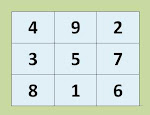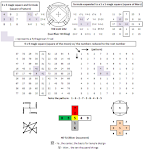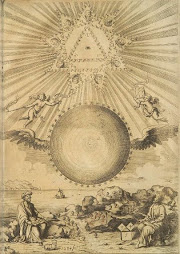The Jesuits and the Magic Square
This is an excerpt from my book Number Time Archetype. The book is on sale, for information contact information is on the right margin.
One of the most fascinating adventures concerning the pursuit of human evolution involves the efforts of Christian missionaries in China from about 1500 to 1800.
One group in particular, the Society of Jesus, whose members were called Jesuits, dominated the Christian mission during this period. The endless list of talented men such as Matteo Ricci, Adam Schall, and Ferdinand Verbiest faced extreme hardships as travel to China could take eighteen months. These men were great mathematicians, astronomers, and scientists who could construct diverse commodities such as a modern canon, a world map, or a cutting edge astronomical observatory equipped with instruments unknown to the Chinese.
There can be no question that the main objective of the Christian mission was to establish a permanent presence in China for the purpose of growing Christianity. Another objective was for an academic and technological exchange of science, wisdom, and information that would be mutually beneficial to both China and the Christian mission. China would be the clear beneficiary during this exchange as Europe was more advanced in science and technology. However, China evolved from the one of the oldest existing cultures and its writing projected images or concepts from the earliest of (civilized) human beings.
Some believe that the pictograms of the early Chinese language and the diagrams from the Yi Jing contain the clues of a Primitive Language, or the writing used before the Flood. The Luo Shu represents one of these diagrams and when decoded, its formula leads the disciple to the “set” of magic squares in the Luo Shu format thus revealing a mystical mathematical language that has functional applications and is directly related to the evolution and prosperity of humankind.
Jesuits Verbiest and Athanasius Kircher demonstrate this esoteric knowledge of the Luo Shu in diagrams from their books which will be discussed later in Chapter Ten.
The Diagram Preceding Heaven is also a diagram from the Yi Jing that when decoded reveals a binary mathematical language that presently is used in the software that allows computers to operate. This binary math was discovered in about 1700 by Father Bouvet, a French Jesuit priest stationed in China, and Gottfried Leibniz, a monumental European figure in science, math, philosophy, and Chinese culture. The Diagram Preceding Heaven shows the sixty-four hexagrams and, according to legend, is linked to Fu Hsi.
These two diagrams, the Luo Shu and the Diagram Preceding Heaven, offer some insight into the significance of complex mathematical relationships that were vestiges of an ancient yet intelligent civilization and could represent the earliest use of numbers and writing (language) known to the academic world. Whether this writing predated the Flood is up for debate, but the Jesuits, and by extension, the Church, were interested in the origins of language and human evolution.
The two diagrams fit the theory that alleges the Chinese language of pictograms can be decoded by mathematics (or musical scales) to reveal a language based on numbers. The two diagrams described here reveal the binary and Pythagorean math that correspond to the numerical language of computers and the measurement of space. Absent are the instructions on how to use these mathematical relationships but once the math is integrated into society evolution and prosperity await humankind.
This is an excerpt from my book Number Time Archetype. The book is on sale, for information contact information is on the right margin.
One of the most fascinating adventures concerning the pursuit of human evolution involves the efforts of Christian missionaries in China from about 1500 to 1800.
One group in particular, the Society of Jesus, whose members were called Jesuits, dominated the Christian mission during this period. The endless list of talented men such as Matteo Ricci, Adam Schall, and Ferdinand Verbiest faced extreme hardships as travel to China could take eighteen months. These men were great mathematicians, astronomers, and scientists who could construct diverse commodities such as a modern canon, a world map, or a cutting edge astronomical observatory equipped with instruments unknown to the Chinese.
There can be no question that the main objective of the Christian mission was to establish a permanent presence in China for the purpose of growing Christianity. Another objective was for an academic and technological exchange of science, wisdom, and information that would be mutually beneficial to both China and the Christian mission. China would be the clear beneficiary during this exchange as Europe was more advanced in science and technology. However, China evolved from the one of the oldest existing cultures and its writing projected images or concepts from the earliest of (civilized) human beings.
Some believe that the pictograms of the early Chinese language and the diagrams from the Yi Jing contain the clues of a Primitive Language, or the writing used before the Flood. The Luo Shu represents one of these diagrams and when decoded, its formula leads the disciple to the “set” of magic squares in the Luo Shu format thus revealing a mystical mathematical language that has functional applications and is directly related to the evolution and prosperity of humankind.
Jesuits Verbiest and Athanasius Kircher demonstrate this esoteric knowledge of the Luo Shu in diagrams from their books which will be discussed later in Chapter Ten.
The Diagram Preceding Heaven is also a diagram from the Yi Jing that when decoded reveals a binary mathematical language that presently is used in the software that allows computers to operate. This binary math was discovered in about 1700 by Father Bouvet, a French Jesuit priest stationed in China, and Gottfried Leibniz, a monumental European figure in science, math, philosophy, and Chinese culture. The Diagram Preceding Heaven shows the sixty-four hexagrams and, according to legend, is linked to Fu Hsi.
These two diagrams, the Luo Shu and the Diagram Preceding Heaven, offer some insight into the significance of complex mathematical relationships that were vestiges of an ancient yet intelligent civilization and could represent the earliest use of numbers and writing (language) known to the academic world. Whether this writing predated the Flood is up for debate, but the Jesuits, and by extension, the Church, were interested in the origins of language and human evolution.
The two diagrams fit the theory that alleges the Chinese language of pictograms can be decoded by mathematics (or musical scales) to reveal a language based on numbers. The two diagrams described here reveal the binary and Pythagorean math that correspond to the numerical language of computers and the measurement of space. Absent are the instructions on how to use these mathematical relationships but once the math is integrated into society evolution and prosperity await humankind.






